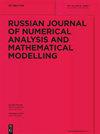分数阶粘弹性血管网络的一维血流动力学模型
IF 0.6
4区 数学
Q4 MATHEMATICS, APPLIED
Russian Journal of Numerical Analysis and Mathematical Modelling
Pub Date : 2023-10-01
DOI:10.1515/rnam-2023-0024
引用次数: 0
摘要
摘要:本文提出了用分数阶粘弹性材料本构法描述动脉壁的一维血流动力学模型的计算框架。该框架用于比较弹性和分数阶粘弹性壁模拟的血流特性。我们使用三种完善的基准测试:长血管中的单脉冲波,37段弹性管网络中的流动,以及由61段动脉组成的解剖详细动脉网络中的流动。弹性模型的所有结果都与解析解、体外数据和其他已建立的方法相一致。分数阶模型显示脉冲波传播速度差异显著,压力和流量分布差异较小。在大血管中,差异可以忽略不计,但在第三代或第四代以上的血管中,差异就更大了。本文章由计算机程序翻译,如有差异,请以英文原文为准。
One-dimensional haemodynamic model of a vascular network with fractional-order viscoelasticity
Abstract We propose a computational framework for a one-dimensional haemodynamic model with the arterial walls described by the fractional-order viscoelastic material constitutive law. This framework is used to compare blood flow characteristics for simulations with elastic and fractional-order viscoelastic walls. We use three well-established benchmark tests: a single pulse wave in a long vessel, flow in a 37-segment network of elastic tubes, and flow in anatomically detailed arterial network consisting of 61 arterial segments. All results for elastic model are in a good agreement with analytical solutions, in vitro data and other well-established approaches. Fractional-order model demonstrates noticeable differences in pulse wave propagation speed and minor differences in pressure and flow profiles. Differences in profiles are negligible in major vessels, but more profound in vessels beyond the third or fourth generation.
求助全文
通过发布文献求助,成功后即可免费获取论文全文。
去求助
来源期刊
CiteScore
1.40
自引率
16.70%
发文量
31
审稿时长
>12 weeks
期刊介绍:
The Russian Journal of Numerical Analysis and Mathematical Modelling, published bimonthly, provides English translations of selected new original Russian papers on the theoretical aspects of numerical analysis and the application of mathematical methods to simulation and modelling. The editorial board, consisting of the most prominent Russian scientists in numerical analysis and mathematical modelling, selects papers on the basis of their high scientific standard, innovative approach and topical interest.
Topics:
-numerical analysis-
numerical linear algebra-
finite element methods for PDEs-
iterative methods-
Monte-Carlo methods-
mathematical modelling and numerical simulation in geophysical hydrodynamics, immunology and medicine, fluid mechanics and electrodynamics, geosciences.

 求助内容:
求助内容: 应助结果提醒方式:
应助结果提醒方式:


